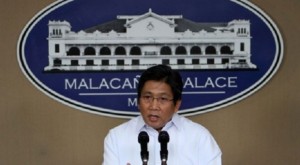
Communication Secretary Herminio Coloma: Best management practice in corporate settings. INQUIRER FILE PHOTO
MANILA, Philippines–Malacañang on Thursday rejected accusations that the P501-billion Special Purpose Funds (SPF) in its proposed 2015 national budget was a form of presidential pork barrel.
Including the amount in next year’s P2.6-trillion budget was consistent with the “best” management practices in corporate settings, Communication Secretary Herminio Coloma said.
“No more,” Coloma replied in Filipino when asked if there was still pork barrel in the new budget proposal.
Citing figures from the six-volume National Expenditure Program, he noted that the SPF included a breakdown to include such items as a calamity fund of P14 billion and a contingency fund of P2 billion.
“Based on established management practice, it is customary that a certain portion of the annual budget is set aside for contingency expenditures that are essentially variable and not amenable to precise determination at the time of budget preparation,” he said.
“The national government, perhaps the largest corporation in the Philippines, follows such best practice in establishing the Special Purpose Funds totaling P501 billion.”
Coloma sought to downplay the magnitude of the SPF, saying it represented “only 19 percent” of the national budget.
SPF questioned
The SPF consists of programmed funds to the tune of P378 billion, and P123 billion worth of unprogrammed funds, which are described as “standby appropriations” with no funding source yet.
In contrast, programmed funds refer to “appropriations for which the availability of funds has already been determined and assured,” Coloma said.
Former National Treasurer Leonor Briones earlier questioned the existence of SPF, saying there was “no historical record on how it started.”
Because items under the SPF are lump sum in nature, administration critics consider it President Aquino’s own pork barrel. In a previous interview, Briones said the “entire Special Purpose Fund is under the control of the President.”
Advocates for budget reform want Congress to minimize lump-sum appropriations to minimize discretion over how funds should be spent after the national budget is passed.
“The budget is the main responsibility of Congress but it allows a majority of it to be left unscrutinized. This should not be the case,” Briones tweeted on Thursday.
Senate scrutiny
Senators Nancy Binay and Francis Escudero said they would scrutinize the lump-sum appropriations.
Binay said it was about time that lawmakers exercise Congress’ power of the purse to scrutinize the proposed General Appropriations Act (GAA), “whether you’re from the majority or minority.”
“After what happened to the DAP (Disbursement Acceleration Program), we will be more detailed in scrutinizing the budget,” Binay told reporters in a Senate press forum.
“So, aside from the SPF, I’ll be asking about items in the budget of each department,” she added.
In last week’s hearing on the DAP, Binay asked probing questions on the allocation of DAP funds for projects that did not spur the economy, including stem cell research.
Voting 13-0, the Supreme Court last month ruled as unconstitutional the DAP, a mechanism introduced in 2011 whereby pooled savings were used to fund fast-moving projects.
While presenting the proposed budget to Speaker Feliciano Belmonte Jr. on Wednesday, Budget Secretary Florencio Abad said that some P501.670 billion was to be set aside as SPFs.
Need for flexibility
As in the past, lump-sum appropriations in the proposed 2015 national budget would also be subject to review by the senators, said Escudero, chair of the finance committee.
“We always scrutinize lump sums,” Escudero told reporters in a phone-patch interview.
He, however, agreed that the government could not do without lump-sum appropriations because these give the government flexibility to deal with disasters and calamities.
“How do we know in advance the road or the building that will be destroyed? How do we know the need at a particular time depending on the calamity that will hit us? The government should have that flexibility,” he said.
Financial control
Coloma said the use of the SPF “involves close, or also requires, close adherence to financial control and accountability measures.”
“This must be fully justified by the concerned head of department or agency and may involve vetting by the appropriate Cabinet cluster before being recommended for approval by the President. Actual disbursement is subject to regular auditing rules and regulations,” he said.
In the Palace proposal, the biggest item in the unprogrammed appropriations in the SPF is P53.9 billion for “equity buyout of the Metro Rail Transit Corp.”
The unprogrammed appropriations also include P30 billion for “risk management program,” P10 billion for the Armed Forces of the Philippines’ modernization program and P1 billion for “general fund adjustments.”
Also on the list are P5 billion in budgetary support for government corporations, P3 billion for foreign-assisted projects, and P20 billion for “infrastructure projects and social programs.”
Coloma acknowledged that there was also a P5-billion allocation in the Department of National Defense budget, but another P10 billion was included in the SPF.
Commitment
“This is to fulfill the government’s commitment of allocating P15 billion a year at the minimum for the AFP modernization program,” he said.
“But since only P5 billion can be covered by available funds, the P10 billion was placed in the unprogrammed portion of the Special Purpose Funds,” he added.
“So, as you can see, that is a specific appropriation for a specific purpose. The only reason why it is under Special Purpose Funds is it will have to be drawn from unprogrammed funds or revenues that will still be realized.”
The SPF in the current national budget is pegged at nearly P450 billion. It includes an allotment of P890.8 million for the Cagayan Economic Zone Authority, which was allotted P1.129 billion in 2009 and another P1.114 billion in 2010.
RELATED STORIES
Gov’t can’t do away with lump sums—Palace
P2.6T national budget has P500B lump sum